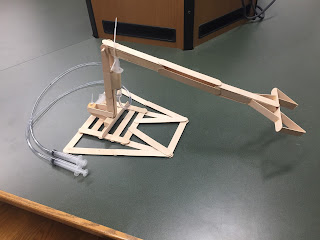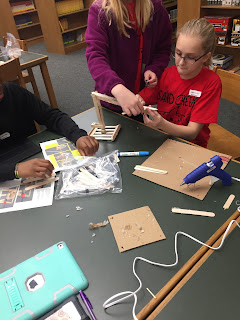 |
| Judobot |
I approached a 6th grade STEM teacher about collaborating on this project. He really liked the design aspect of the project and agreed to have his classes participate. I got all the materials ready and he created 3-4 member teams. We showed them my model, explained the workings of hydraulics and handed out criteria for the robots. The students were shown a video of a battle between 2 Judobots and teams discussed how they wanted to approach designing their Judobot.
The classes would meet in the media center where design and creation would take place. Glue gun stations were set up along with a cutting and drilling station. Each robot base had to fit in a 12"X12" frame in order to level the playing field. (enlarging the base would lead to making it more difficult to tip over)
Once the Judobot was built, students would then add the hydraulics in order to be able to move the arm vertically and horizontally. Once the Judobot was functional students began competing in a preliminary round robin type tourney to gauge how well their design worked. Afterwards teams were able to make modifications before the actual tournament.
I was amazed at the conversations the teacher was having during the design and creation process with his students. He had then drawing back from lessons learned back in fourth grade math in order to solve their problems. Students discussed ideas with one another and considered everyone's opinions prior to moving forward. It was truly STEM.
The classes would meet in the media center where design and creation would take place. Glue gun stations were set up along with a cutting and drilling station. Each robot base had to fit in a 12"X12" frame in order to level the playing field. (enlarging the base would lead to making it more difficult to tip over)
Once the Judobot was built, students would then add the hydraulics in order to be able to move the arm vertically and horizontally. Once the Judobot was functional students began competing in a preliminary round robin type tourney to gauge how well their design worked. Afterwards teams were able to make modifications before the actual tournament.
I was amazed at the conversations the teacher was having during the design and creation process with his students. He had then drawing back from lessons learned back in fourth grade math in order to solve their problems. Students discussed ideas with one another and considered everyone's opinions prior to moving forward. It was truly STEM.
 |
| Teamwork |
 |
| Design and Construction |
Battle on!
Reflecting on this activity with the STEM teacher we both agreed it was a worthwhile activity. He came up with the idea of pricing out all the equipment and giving each team a budget in order to have them decide how they would want to spend their budget. We discussed allowing them opportunities throughout the process to earn chances to increase their budget to purchase items that may enhance their Judobot.
I look forward to our next opportunity to do battle and may even consider having a teacher team design and create a Judobot to do battle with our student champions. I'm certain students would relish the chance to defeat their teachers in battle!
Check out this video created by the teacher about the process - http://safeyoutube.net/w/VfIc




